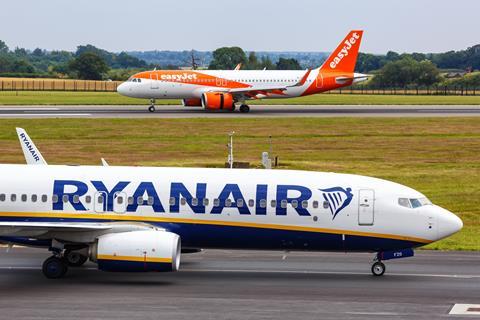With airline executives queuing up to report post-Covid ‘normalisation’ trends in yields and demand over the past few months, it comes as something of a surprise to hear a different narrative from EasyJet.
The UK-based low-cost carrier had joined other local airlines in seeing its shares tumble on 22 July after Ryanair reported softer-than-expected fares during the April-June period and said they would be “materially lower” in the peak July-September quarter.
Without price stimulation, consumers were not spending, Ryanair said.
Carriers including Finnair and Norwegian had made similar observations on demand and fare softness during their earnings calls.

And airline executives at this week’s Farnborough air show largely echoed Ryanair’s sentiment, saying it was an inevitable development as pent-up demand dissipates and the mixed economic picture starts to show through in consumer spending patterns.
But on 24 July EasyJet released its own trading update for April-June period and firmly bucked the trend.
“Bookings for Q4 continue to build, with 69% now sold, +1 ppt year-on-year with 7% more capacity on sale,” it says.
“This means EasyJet has currently sold 1.5 million more seats for peak summer compared to the same point in time last year with total yield broadly flat year on year.
“Looking to [the first quarter of 2025], on sale capacity is up c.5% with 20% of the programme currently sold, +2 ppts year-on-year,” it adds.
And after Ryanair and other carriers complained about aircraft delivery delays, EasyJet said of the April-June period: “All 16 aircraft, as expected, have been taken into ownership and delivered with the final one received in July.”
Does this mean EasyJet’s more cautious emergence from the pandemic in terms of capacity has combined with its primary airport-focused network strategy, aircraft upgauging, boosting of ancillary revenues and growth of its holidays business to give it a strategic edge?
“This result was achieved despite Easter falling into March this year, demonstrating the continued importance of travel and this means we remain on track to deliver another record-breaking summer, taking us a step closer to our medium term targets,” says EasyJet chief executive Johan Lundgren.
But analysts were struggling to make sense of the dichotomy of narratives in Europe’s low-cost sector, notably given Ryanair and EasyJet share many markets.
“This raises more questions than it answers: a gap of this magnitude between Europe’s two largest point to point airlines is unusual,” says Bernstein analyst Alex Irving.
One contributing factor, Irving suggests, is that Ryanair faces tougher comparisons in terms of ticket yields compared with pre-Covid levels, with the Irish carrier at +21% versus 2019 and easyJet at +8%, the latter having increased its stage length during over the past few years, diluting its figure.
“Yet this explanation seems inadequate given [year on year] fare developments, and the more comparable period in terms of network and fleet is 12 months ago not 60,” he states.
More fundamentally, analysts at HSBC see EasyJet having some strategic advantages thanks to its focus on primary airports.
”More than 80% of EasyJet’s capacities are at constrained or fully constrained airports where it competes with expensive airlines (KLM, SWISS, Air-France, etc),” HSBC says. “In the current inflationary environment, we expect passengers to increasingly seek value for money, likely benefiting EasyJet, which we expect to outperform this year.”
Undeniably this will make the European short-haul market a fascinating watch over the coming months; can the EasyJet and Ryanair narratives exist side-by-side, will their fortunes converge, or will one be proven correct?
“Ryanair’s assessment that ‘the consumer is under significant pressure across Europe’ does not seem as robust as it did,” according to Irving.
But HSBC expects EasyJet to be an outlier in terms of earnings in the lastest period.
“We consider it likely that EasyJet will be the only European airline delivering an earnings improvement [year on year in the] last quarter,” it says.
EasyJet reported a third-quarter headline profit before tax of £236 million ($304 million), which was up £33 million year on year.
Group revenue was up 11% at £2.6 billion, including a 42% rise in holidays revenue to £336 million.
Passenger revenue per seat was down 1% year on year, with ancillary revenue 4% higher on the same basis, leaving overall revenue per seat up 1%. Headline costs per seat dropped 1%.
EasyJet had already demonstrated some progress on its core strategic priorities during the first half of its fiscal year.
It managed to cut is losses in that seasonally weak period, while also boosting ancillary revenues significantly.
